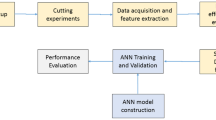Abstract
Ultrasonic metal welding (USMW) is a highly attractive joining technology due to high energy efficiency and solid-state joint formation. Various joining solutions for conductor materials can be realized with USMW. Still, a big challenge for complex industrial applications is an adequate process monitoring that allows to cope with inevitable and complex process fluctuations. In this work, the suitability of contactless temperature measurements for process monitoring of copper sheet welding is examined and compared with the suitability of vibration measurements by means of machine learning methods. Different sensor signals acquired during welding on a metrological test rig are used for predicting the tensile shear strength of the joint. Results show that quality predictions based on temperatures exceed the state-of-the-art monitoring based on the welding energy. Yet, solely temperature-based predictions are exceeded by quality predictions based on either welding machine signals or tool vibration measurements. To further explore temperature-based quality analysis, joint microstructure analyses are carried out. These reveal concurring joint formation mechanisms associated with the mechanical and thermal process domains. To finally cover both domains in quality prediction, a sensor-fusion-based regression model is set up relying on vibration and temperature measurements. This fusion model exceeds all previously considered regression models with a mean absolute percentage error of 7.4% on the test data set. These results stress the importance of both process domains and suggest the combination of temperature and vibration measurements as a good starting point for future industrial monitoring of USMW processes.














Similar content being viewed by others
References
Wodara J (2004) Ultraschallfuegen und -trennen. DVS Fachbuchreihe DVS Media GmbH
Golde H-D (1997) Ultrasonic metal welding: principles and applications of high-grade bonding technology Verlage Moderne Industrie / Stapla Ultrasonics Corporation
Greitmann MJ, Adam T, Holzweissig HG, Stroh D, Wagner G, Wiesner P, Zuest R (2003) Gegenwaertiger Stand und ZukunftSaussichten Sonderschweissverfahren - Ultraschallmetallschweissen. Schweissen & Schneiden 306–314
Balz I, Raad EA, Rosenthal E, Lohoff R, Schiebahn A, Reisgen U, Vorlaender M (2020) Process monitoring of ultrasonic metal welding of battery tabs using external sensor data. J Adv Join Process 1:100005. https://doi.org/10.1016/j.jajp.2020.100005
Bergmann JP, Regensburg A, Schuerer R, Petzoldt F, Herb A (2017) Effect of the interface characteristics on the joint properties and diffusion mechanisms during ultrasonic metal welding of Al/Cu. Weld World 61(3):499–506. https://doi.org/10.1007/s40194-017-0449-6https://doi.org/10.1007/s40194-017-0449-6
Satpathy MP, Sahoo SK (2016) Microstructural and mechanical performance of ultrasonic spot welded Al–Cu joints for various surface conditions. J Manuf Process 22:108–114. https://doi.org/10.1016/j.jmapro.2016.03.002https://doi.org/10.1016/j.jmapro.2016.03.002
Regensburg A, Petzoldt F, Schuerer R, Hellwig P, Bergmann JP (2017) Effect of local preheating during ultrasonic welding of Al-Cu joints on strand compaction and bond formation. Weld World 61:443–451. https://doi.org/10.1007/s40194-017-0434-0
Li H, Choi H, Ma C, Zhao J, Jiang H, Cai W, Abell JA, Li X (2013) Transient temperature and heat flux measurement in ultrasonic joining of battery tabs using thin-film microsensors. J Manuf Sci Eng 135(5). https://doi.org/10.1115/1.4024816
Schwarz EB, Bleier F, Guenter F, Mikut R, Bergmann JP (2022) Improving process monitoring of ultrasonic metal welding using classical machine learning methods and process-informed time series evaluation. J Manuf Process 77:54–62. https://doi.org/10.1016/j.jmapro.2022.02.057
Lu Y, Song H, Taber GA, Foster DR, Daehn GS, Zhang W (2016) In-situ measurement of relative motion during ultrasonic spot welding of aluminum alloy using Photonic Doppler Velocimetry. J Mater Process Technol 231:431–440. https://doi.org/10.1016/j.jmatprotec.2016.01.006
Shi X, Yu S, Li L, Zhao J (2021) Anvil state identification based on acceleration signals in ultrasonic metal welding of lithium batteries. J Manuf Process 70:67–77. https://doi.org/10.1016/j.jmapro.2021.08.023https://doi.org/10.1016/j.jmapro.2021.08.023
Balz I, Rosenthal E, Reimer A, Turiaux M, Schiebahn A, Reisgen U (2019) Analysis of the thermo-mechanical mechanism during ultrasonic welding of battery tabs using high-speed image capturing. Weld World 63(6):1573–1582. https://doi.org/10.1007/s40194-019-00788-zhttps://doi.org/10.1007/s40194-019-00788-z
Zhao J, Li H, Choi H, Cai W, Abell JA, Li X (2013) Insertable thin film thermocouples for in situ transient temperature monitoring in ultrasonic metal welding of battery tabs. J Manuf Process 15 (1):136–140. https://doi.org/10.1016/j.jmapro.2012.10.002
Zhou B, Pychynski T, Reischl M, Kharlamov E, Mikut R (2022) Machine learning with domain knowledge for predictive quality monitoring in resistance spot welding. J Intell Manuf 33:1139–1163. https://doi.org/10.1007/s10845-021-01892-y
Meng Y, Rajagopal M, Kuntumalla G, Toro R, Zhao H, Chang HC, Sundar S, Salapaka S, Miljkovic N, Ferreira P, Sinha S, Shao C (2020) Multi-objective optimization of peel and shear strengths in ultrasonic metal welding using machine learning-based response surface methodology. Math Biosci Eng 17:7411–7427. https://doi.org/10.3934/mbe.2020379
Satpathy MP, Moharana BR, Dewangan S, Sahoo SK (2015) Modeling and optimization of ultrasonic metal welding on dissimilar sheets using fuzzy based genetic algorithm approach. Eng Sci Technol, Int J 18(4):634–647. https://doi.org/10.1016/j.jestch.2015.04.007https://doi.org/10.1016/j.jestch.2015.04.007
Elangovan S, Anand K, Prakasan K (2012) Parametric optimization of ultrasonic metal welding using response surface methodology and genetic algorithm. Int J Adv Manuf Technol 63(5):561–572. https://doi.org/10.1007/s00170-012-3920-y
Yang Y, Shao C (2021) Hybrid multi-task learning-based response surface modeling in manufacturing. J Manuf Syst 59:607–616. https://doi.org/10.1016/j.jmsy.2021.04.012
Zhao D, Ren D, Zhao K, Pan S, Guo X (2017) Effect of welding parameters on tensile strength of ultrasonic spot welded joints of aluminum to steel: by experimentation and artificial neural network. J Manuf Process 30:63–74. https://doi.org/10.1016/j.jmapro.2017.08.009https://doi.org/10.1016/j.jmapro.2017.08.009
Nazir Q, Shao C (2021) Online tool condition monitoring for ultrasonic metal welding via sensor fusion and machine learning. J Manuf Process 62:806–816. https://doi.org/10.1016/j.jmapro.2020.12.050https://doi.org/10.1016/j.jmapro.2020.12.050
Mongan PG, Hinchy EP, O’Dowd NP, McCarthy CT (2021) Quality prediction of ultrasonically welded joints using a hybrid machine learning model. J Manuf Process 71:571–579. https://doi.org/10.1016/j.jmapro.2021.09.044
Greitmann MJ, Volz O, Wackenhut G, Wink H. -J. (2005) Qualitaetssicherung beim Ultraschallschweissen mit Hilfe neuronaler Netze. Schweissen & Schneiden 627–637
Guo W, Shao C, Kim TH, Hu SJ, Jin J, Spicer JP, Wang H (2016) Online process monitoring with near-zero misdetection for ultrasonic welding of lithium-ion batteries: an integration of univariate and multivariate methods. J Manuf Syst 38:141–150. https://doi.org/10.1016/j.jmsy.2016.01.001
Shao C, Paynabar K, Kim TH, Jin J, Hu SJ, Spicer JP, Wang H, Abell JA (2013) Feature selection for manufacturing process monitoring using cross-validation. J Manuf Syst 32(4):550–555. https://doi.org/10.1016/j.jmsy.2013.05.006
Mueller FW, Schiebahn A, Reisgen U (2022) Quality prediction of disturbed ultrasonic metal welds. J Adv Join Process 5:100086. https://doi.org/10.1016/j.jajp.2021.100086
Balz I (2020) Doctoral Thesis: Prozessanalyse der thermomechanischen Vorgaenge waehrend der Verbindungsbildung beim Metall-Ultraschallschweissen RWTH Aachen
Schwarz EB, Bleier F, Guenter F, Bergmann JP (2022) One-dimensional numerical model for thermal domain analysis with respect to process fluctuations in ultrasonic metal welding. In: Proceedings of the Int. Conference on Electrical Contacts
Pedregosa F, Varoquaux G, Gramfort A, Michel V, Thirion B, Grisel O, Blondel M, Prettenhofer P, Weiss R, Dubourg V, Vanderplas J, Passos A, Cournapeau D, Brucher M, Perrot M, Duchesnay E (2011) Scikit-learn: Machine Learning in Python. J Mach Learn Res 12:2825–2830
McKinney W (2010) Data structures for statistical computing in python. In: Proceedings of the 9th python in science conference, pp 56–61. https://doi.org/10.25080/Majora-92bf1922-00a
Siebertz K, van Bebber D, Hochkirchen T (2017) Statistische Versuchsplanung - Design of Experiments (DoE), 2nd edn. Springer, Berlin
Sanga B, Wattal R, Nagesh DS (2018) Mechanism of joint formation and characteristics of interface in ultrasonic welding: Literature review. Period Eng Nat Sci 6 (1):107–119. https://doi.org/10.21533/PEN.V6I1.158
Bergmann JP, Koehler T, Poethig P (2021) Ultrasonic welding. In: Da Silva L, El-Zein M, Martins P (eds) Advanced joining processes. https://doi.org/10.1016/B978-0-12-820787-1.00007-3https://doi.org/10.1016/B978-0-12-820787-1.00007-3, pp 239–267
Langenecker B (1966) Effects of ultrasound on deformation characteristics of metals. IEEE Trans Son Ultrason 13:1–8. https://doi.org/10.1109/T-SU.1966.29367
Acknowledgements
Ingo Kesel and Tobias Beck are acknowledged for help with microstructural investigations and for fruitful discussions.
Funding
This research project received funding by the German Federal Ministry for Economic Affairs and Energy (BMWi) within the funding programme ‘Elektro-Mobil’ (FKZ 01MV18003C / EProFIL) according to a decision of the German Federal Parliament. The authors are responsible for the contents of this publication.
Author information
Authors and Affiliations
Corresponding author
Ethics declarations
Conflict of interest
The authors declare no competing interests.
Additional information
Author contribution
E.B. Schwarz — conceptualization, methodology, investigation, software, validation, writing — original draft, writing — review and editing. F. Bleier — conceptualization, writing — review and editing. F. Guenter — conceptualization, writing — review and editing. R. Mikut — conceptualization, writing — review and editing. J.P. Bergmann — conceptualization, writing — review and editing, supervision. All authors have approved the manuscript.
Publisher’s note
Springer Nature remains neutral with regard to jurisdictional claims in published maps and institutional affiliations.
Recommended for publication by Commission IX - Behaviour of Metals Subjected to Welding
Rights and permissions
Springer Nature or its licensor (e.g. a society or other partner) holds exclusive rights to this article under a publishing agreement with the author(s) or other rightsholder(s); author self-archiving of the accepted manuscript version of this article is solely governed by the terms of such publishing agreement and applicable law.
About this article
Cite this article
Schwarz, E.B., Bleier, F., Guenter, F. et al. Temperature-based quality analysis in ultrasonic welding of copper sheets with microstructural joint evaluation and machine learning methods. Weld World 67, 1437–1448 (2023). https://doi.org/10.1007/s40194-023-01463-0
Received:
Accepted:
Published:
Issue Date:
DOI: https://doi.org/10.1007/s40194-023-01463-0




